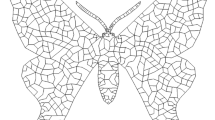Abstract
Constrained Delaunay Triangular Irregular Networks (CD-TIN), a kind of special data structure, have many practical applications in Geoinformatics, especially in the representation of linear constrained triangulation for DTM and DSM, such as in digital city and digital mine. Past researches on D-TIN mainly focused on point insertion and deletion without consideration of constraint, and that on CD-TIN usually paid more attention to the insertion algorithms for points and edges, but little to the deletion algorithms. The presented algorithms are far insufficient for the dynamic updating of CD-TIN. In this paper, the constraint edge in CD-TIN is considered to be any set of broken lines, i.e., polygon edges, broken lines and simple segments. The constraint edge may be composed of one or more constraint segments, and it is allowed to be in any form: Open or close, intersection or self-intersection. By improving to present insertion and deletion algorithms for D-TIN, two new algorithms for CD-TIN updating are presented. According to the polymorphism of the constraints in CD-TIN, virtual point is adopted to represent the crossing node between constraint edges when a constraint edge is inserted in CD-TIN. Two new algorithms named as Integral Ear Elimination (IEE) and Influence Domain Retriangulation for Virtual Point (IDRVP) are presented, the former is for constraint point deletion, while the later is for the insertion and deletion of constraint edge. The principle of IDRVP is that to divide the influence domain of a virtual point into some parts by the constraint-keeping edges, and to retriangulate each part of the influence domain individually referring to the constraint visible property and constraint empty circle (CEC) criterion. Finally, a prototype system is developed with VC++, one case on the integration of 3D terrain and buildings is demonstrated to test the correctness of new algorithms. It shows that the new algorithms are effective for the updating of CD-TIN.
Similar content being viewed by others
References
Aurenhammer F. Power diagrams: Properties, algorithms, and applications. SIAM J Comput, 1987, 16(1): 78–96
Mostafavi M A, Gold C, Dakowicz M. Deletion and insert operations in Voronoi/Delaunay methods and applications. Comput Geo Sci, 2003, 23: 523–530
Zhu X X. Free Curved Lines and Face Modeling Technology (in Chinese). Beijing: Science Press, 2000. 215–235
Zhong D H, Li M C, Liu J. 3D integrated modeling approach to geo-engineering objects of hydraulic and hydroelectric projects. Sci China Ser E-Tech Sci, 2007, 50(3): 329–342
Yang C S, Zhu C Q, Tao D X. A surface interpolation model of DEM at the TIN nodes. Geogr Geo-Inf Sci (in Chinese), 2007, 23(1): 39–41
Dwyer R A. A fast divide-and-conquer algorithm for constructing Delaunay triangulations. Algorithmica, 1987, 2: 137–151
Guibas L, Stolfi J. Primitives for the manipulation of general subdivisions and the computation of Voronoi diagrams. ACM T Graphic, 1985, 4(2): 75–123
Fortune S. A sweepline algorithm for voronoi diagrams. Algorithmica, 1987, 2: 153–174
Preparata F P, Shamos M I. Computational Geometry, an Introduction. New York: Springer-Verlag, 1985
Green E, Sibson R. Computing dirichlet tessellations in the plane. Comput J, 1977, 21: 168–173
Guibas L, Knuth D, Sharir M. Randomized incremental construction of Delaunay and Voronoi diagrams. Algorithmica, 1992, 7: 381–413
Ohya T, Iri M, Murota K. Improvements of the incremental method for the Voronoi diagram with computational comparison of various algorithms. J Oper Res Soc, 1984, 27: 306–337
Chew L P. Constraint delaunay triangulations. In: Proceedings of the Annual Symposium on Computational Geometry ACM, 1987. 215–222
Devillers O. On deletion in Delaunay triangulations. In: 15th Annual ACM Symposium on Computational Geometry, 1999. 181–188
Jia X L, Wu L X, Wang Y B. Two dimensional local updating for delaunay TIN: Point insertion and point deletion. Geogr Geo-Inf Sci (in Chinese), 2004, 20(5): 28–31
Marc V, Núria P, Josep C. Regular triangulations of dynamic sets of points. Comput Aided Geom D, 2002, 19: 127–149
Li Z L, Zhu Q. Digital Elevation Model (in Chinese). Wuhan: Wuhan Surveying and Mapping University Press, 2000
Chew L P. Constraint Delaunay triangulations. Algorithmica, 1989, 4: 97–108
Hao H S, Wu L X. 3D-geosciences modeling and visualization based on strongly constraint delaunay TIN. Geogr Geo-Inf Sci (in Chinese), 2003, 19(2): 15–18
Lee D T, Lin H K. Generalized Delaney Triangulation for planar graphs. Discrete Comput Geom, 1986, 1: 201–217
Piegl L A, Arnaud M R. Algorithm and Data Structure for Triangulation Multiply Connected Polygonal Domains. Comput Graph, 1993, 17(5): 563–574
Okabe A, Boots B, Sugihara K, et al. Spatial Tessellations: Concepts and Applications of Voronoi Diagrams. Chichester: Wiley, 2000. 671
Marc V. An incremental algorithm for constructing restricted delaunay triangulations. Comput Graph, 1997, 21(2): 215–223
Marc V, NuHria P. Computing directional constraint Delaunay triangulations. Comput Graph, 2000, 24: 181–190
Pan S L, Liu X J, et al. Reconstruction of topological relation in TIN based on hash function. Geogr Geo-Inf Sci (in Chinese), 2006, 22(2): 21–24
Heller M. Triangulation algorithms for adaptive terrain modeling. In: Proceedings of Fourth International Symposium on Spatial Data Handling, 1990. 163–174
Lawson C L. Software for C1 Surface Interpolation. USA: Academic Press, 1977. 161–194
Author information
Authors and Affiliations
Corresponding author
Additional information
Supported by the National Natural Science Funds of China for Outstanding Youth (Grant No. 50525414), the National Natural Science Foundation of China (Grant Nos. 10172090, 40771171), the National Hi-Tech Research and Development Program of China (Grant No. 2006AA12Z216) and Science Development Plan Awarded by Beijing Municipal Commission of Education Science (Grant No. KM200710028014)
Rights and permissions
About this article
Cite this article
Wu, L., Wang, Y. & Shi, W. Integral ear elimination and virtual point-based updating algorithms for constrained Delaunay TIN. Sci. China Ser. E-Technol. Sci. 51 (Suppl 1), 135–144 (2008). https://doi.org/10.1007/s11431-008-5018-1
Received:
Accepted:
Published:
Issue Date:
DOI: https://doi.org/10.1007/s11431-008-5018-1




